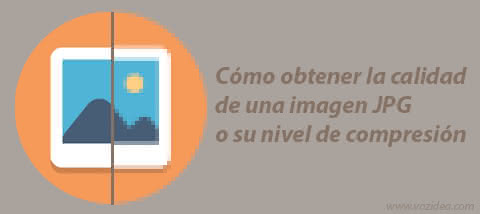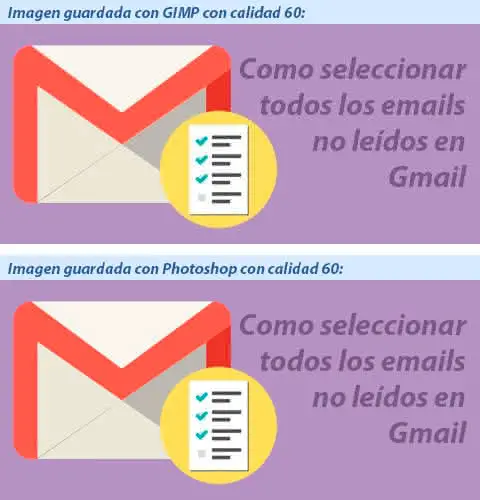It is usual to download images that we find on the internet to include in our articles or documents. Many of these images are in
JPG format, which allows us to establish a quality level between 0 and 100 or compression level
. The objective of this tutorial is
how to find out the quality of a JPG image and thus determine its compression level
.

When we talk about the
best program to optimize images
, we dedicate a section to talk about images in JPG format, which I recommend reading. What we should be clear about is that
the JPG format is a format with losses and every time we save an image in this format we are losing quality
.
How to get the quality of a JPG image or its compression level.
As we said at the beginning, when we save an image in JPG format we can set the quality with a number between 0 and 100.
In some programs this parameter is referred to as compression level, but it is usual to designate it as quality.
When we download an image in JPG format, there is no direct way to find out its quality or compression level.
The format does not save this information, although it is true that some programs add this information in
the image metadata
, it is not usual.
Despite all this, there is a method to find out the quality parameter of a JPG, for which we will use the free and cross-platform
ImageMagick
software. Within the ImageMagick package we will find the
identify
program, which allows us to obtain detailed information of an image.
To find out the quality of a JPG, we execute the following command from the command
line
:
identify -format '%Q' laimagen.jpg

We see that it will show us the quality number on the screen, represented by its value.
Considerations when interpreting the quality of a JPG image.
We must be clear that
the overall quality of a JPG file does not depend solely on the established quality parameter, but other parameters such
as chroma subsampling, quantization tables, etc. are involved. With this, what I want to show you, is that the quality of the same JPG image can vary if we save it with different programs, even if we use the same quality parameter.
To demonstrate it you can see the following image, which in both cases has been saved with a quality parameter 60, but the first image has been saved with GIMP and the second with Photoshop.

If you look, we can see that the image saved with Photoshop offers higher overall quality than the one saved with GIMP. We also have to consider that the image saved with Photoshop has a size of 15.5KB while the image saved with GIMP 9.91KB.
But this difference in size has an explanation and is that the quality chosen in Photoshop of 60, actually corresponds to a quality parameter 86.
Then I leave the complete data of the two images compared:
C:\ImageMagick-7.0.5-0-portable>identify -verbose test_gimp.jpg
Image: test_gimp.jpg
Format: JPEG (Joint Photographic Experts Group JFIF format)
Mime type: image/jpeg
Class: DirectClass
Geometry: 480x220+0+0
Resolution: 72x72
Print size: 6.66667x3.05556
Units: PixelsPerInch
Type: TrueColor
Endianess: Undefined
Colorspace: sRGB
Depth: 8-bit
Channel depth:
Red: 8-bit
Green: 8-bit
Blue: 8-bit
Channel statistics:
Pixels: 105600
Red:
min: 0 (0)
max: 255 (1)
mean: 192.338 (0.754266)
standard deviation: 40.7007 (0.159611)
kurtosis: -0.59641
skewness: 0.193754
entropy: 0.508844
Green:
min: 45 (0.176471)
max: 255 (1)
mean: 157.433 (0.617385)
standard deviation: 48.0412 (0.188397)
kurtosis: -0.460929
skewness: 0.541649
entropy: 0.547715
Blue:
min: 18 (0.0705882)
max: 255 (1)
mean: 177.084 (0.694446)
standard deviation: 46.2831 (0.181502)
kurtosis: 0.581174
skewness: -1.11279
entropy: 0.557997
Image statistics:
Overall:
min: 0 (0)
max: 255 (1)
mean: 175.618 (0.688699)
standard deviation: 47.325 (0.185588)
kurtosis: -0.342889
skewness: -0.226262
entropy: 0.538186
Rendering intent: Perceptual
Gamma: 0.454545
Chromaticity:
red primary: (0.64,0.33)
green primary: (0.3,0.6)
blue primary: (0.15,0.06)
white point: (0.3127,0.329)
Matte color: grey74
Background color: white
Border color: srgb(223,223,223)
Transparent color: none
Interlace: JPEG
Intensity: Undefined
Compose: Over
Page geometry: 480x220+0+0
Dispose: Undefined
Iterations: 0
Compression: JPEG
Quality: 60
Orientation: Undefined
Properties:
date:create: 2017-03-02T16:27:01+01:00
date:modify: 2017-03-02T16:27:01+01:00
jpeg:colorspace: 2
jpeg:sampling-factor: 1x1,1x1,1x1
signature: a0ecd9fc0fe16532fd6a71e4055d410a86ff90e555dcc8dbb213c9ab7364a633
Artifacts:
verbose: true
Tainted: False
Filesize: 9.91KB
Number pixels: 106K
Pixels per second: 17.6MB
User time: 0.016u
Elapsed time: 0:01.006
Version: ImageMagick 7.0.5-0 Q16 x64 2017-02-20 http://www.imagemagick.org
C:\ImageMagick-7.0.5-0-portable>identify -verbose test_photoshop.jpg
Image: test_photoshop.jpg
Format: JPEG (Joint Photographic Experts Group JFIF format)
Mime type: image/jpeg
Class: DirectClass
Geometry: 480x220+0+0
Units: Undefined
Type: TrueColor
Endianess: Undefined
Colorspace: sRGB
Depth: 8-bit
Channel depth:
Red: 8-bit
Green: 8-bit
Blue: 8-bit
Channel statistics:
Pixels: 105600
Red:
min: 0 (0)
max: 255 (1)
mean: 192.711 (0.755728)
standard deviation: 40.5036 (0.158838)
kurtosis: -0.461151
skewness: 0.153411
entropy: 0.522216
Green:
min: 41 (0.160784)
max: 255 (1)
mean: 157.996 (0.619592)
standard deviation: 48.1356 (0.188767)
kurtosis: -0.460604
skewness: 0.523291
entropy: 0.545854
Blue:
min: 29 (0.113725)
max: 255 (1)
mean: 177.555 (0.696293)
standard deviation: 46.9984 (0.184308)
kurtosis: 0.520238
skewness: -1.11799
entropy: 0.556904
Image statistics:
Overall:
min: 0 (0)
max: 255 (1)
mean: 176.087 (0.690538)
standard deviation: 47.512 (0.186322)
kurtosis: -0.324822
skewness: -0.258086
entropy: 0.541658
Rendering intent: Perceptual
Gamma: 0.454545
Chromaticity:
red primary: (0.64,0.33)
green primary: (0.3,0.6)
blue primary: (0.15,0.06)
white point: (0.3127,0.329)
Matte color: grey74
Background color: white
Border color: srgb(223,223,223)
Transparent color: none
Interlace: None
Intensity: Undefined
Compose: Over
Page geometry: 480x220+0+0
Dispose: Undefined
Iterations: 0
Compression: JPEG
Quality: 86
Orientation: Undefined
Properties:
date:create: 2017-03-02T16:28:10+01:00
date:modify: 2017-03-02T16:28:11+01:00
jpeg:colorspace: 2
jpeg:sampling-factor: 1x1,1x1,1x1
signature: 7e7c7e918d7d2f7e8fd340f7c775f1ff72ac43b6c7870446a1c41311209b80b0
Profiles:
Profile-app12: 15 bytes
Profile-exif: 22 bytes
Profile-xmp: 766 bytes
Artifacts:
verbose: true
Tainted: False
Filesize: 15.5KB
Number pixels: 106K
Pixels per second: 26.4MB
User time: 0.000u
Elapsed time: 0:01.003
Version: ImageMagick 7.0.5-0 Q16 x64 2017-02-20 http://www.imagemagick.org
Finally, I also want to clarify that
if a JPG image that has been saved with the quality parameter with a value of 80, if we save it again with a quality parameter 90, the quality will not improve
. This is because the JPG format is a lossy format.
For the above reason it is so important to know the quality of a JPG image that we download from the internet, so as not to save it with higher quality than necessary and not waste space.